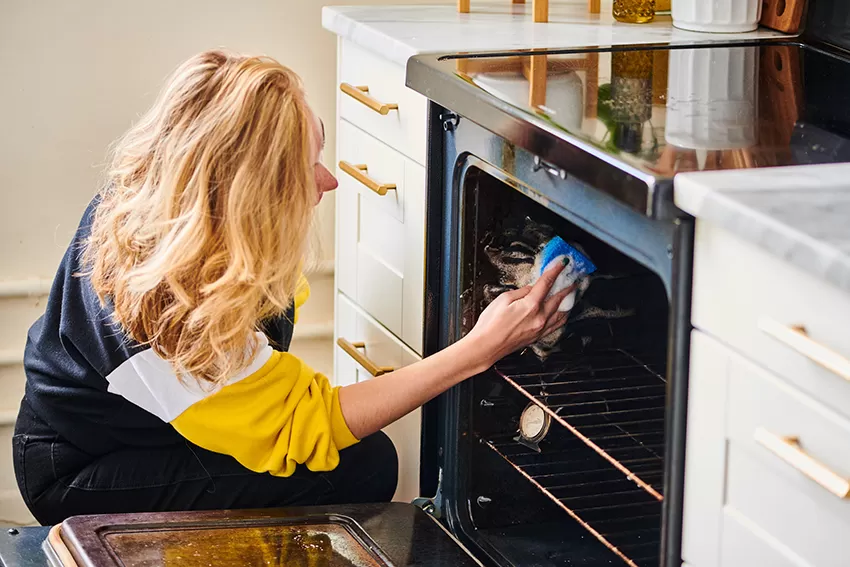
Your oven is one of the most used appliances in the kitchen. No matter how careful you are, spills and splatters happen. Food remnants and grease build up over time.
This can not only make your oven less efficient but also become a fire hazard. So how often should you deep clean your oven?
Oven Cleaning Frequency
According to Liverpool based professional oven cleaners Dirtbusters, many ovens only need a thorough clean 1-4 times per year. The cleaning frequency depends on several factors:
-
How Often You Use the Oven
If you bake multiple times per week, more frequent cleaning is needed. Daily oven use means quarterly or monthly deep cleaning. Occasional baking may only need 1-2 yearly cleans.
-
What You Cook
Foods prone to splattering like roasts, pies, and casseroles cause more buildup. Sticky, sugary baked goods also leave more residue. Low-mess foods like grill chicken need less cleaning.
-
Oven Type
Self-cleaning oven models can go longer between deep cleans. However, wiping spills quickly still helps. Manual clean ovens need more elbow grease each time.
-
Oven Location
An oven underneath a cooktop gets extra splatter drippings. This dual setup needs vigilant cleaning to avoid grease fires. Wall ovens tend to stay cleaner.
Quick Tips for Keeping Your Oven Clean
While periodic deep cleaning is still required, some quick tips help keep your oven tidier between major cleans:
-
Use Baking Soda – Sprinkling baking soda on the oven floor before cooking helps absorb splatters and drips. The anti-stick properties keep food from sticking too.
-
Clean up Spills ASAP – Don’t let food spills sit in the oven and bake on. Wiping messes immediately makes cleaning much easier.
-
Use a Splatter Screen – A splatter guard/splash screen over dishes helps minimise mess during roasting or baking wet batters.
-
Line Pans and Racks – Foil or baking paper on oven racks and pans helps contain drips and crumbs for easier cleanup.
-
Keep Oven Racks Clean – Remove racks and wash regularly in warm soapy water. Burnt on debris affects airflow and cooking efficiency.
-
Vacuum the Oven – Use a crevice tool to vacuum around the oven gasket, racks, vents and corners occasionally to remove crumbs and residue.
-
Check the Oven Window – Clean glass doors regularly to allow monitoring food without opening the oven.
-
Deal with Spills Head-on – Harsh oven cleaners help dissolve baked-on spills and grease. Apply and let sit before scrubbing.
-
Maintain Air Flow – Keep oven vents unclogged so heat and air flow evenly for efficient cooking.
How to Deep Clean Your Oven
For periodic deep cleaning, tackling all the surfaces thoroughly removes unhealthy grease buildup and restores the oven’s shine.
What You Need
- Protective gloves
- Old cloths, sponges, toothbrush
- Oven cleaning spray or gel
- Non-scratching scrub pads
- Baking soda and vinegar
Remove Oven Racks
Take out all removable racks, trays, pans and grates. Scrub with baking soda and water paste then rinse clean.
Apply Oven Cleaner
Cover oven surfaces with a thick layer of store bought oven cleaner gel or spray. Avoid bare hands. Let sit overnight.
Scrub Away Grime
Use a non-scratching scrub pad to work away grease and grime. Pay attention to crevices and the oven door seal.
Rinse Surfaces
Wipe down all surfaces thoroughly with water on a cloth or sponge to rinse away residue. Dry completely with a lint free cloth.
Stubborn Spots
For baked-on spills, apply baking soda directly and spritz with vinegar. Let bubble then scrub with a brush or cloth. Rinse.
Replace Oven Racks
Once fully dry, return oven racks, trays, grates and other accessories. Your oven will look refreshed and new!
Alternative Oven Cleaning Methods
If you want to avoid harsh chemicals, these DIY methods work well for light oven cleaning:
Baking Soda and Water Paste
Mix baking soda with just enough water to form a spreadable paste. Apply and let sit before wiping and rinsing clean. The abrasiveness of baking soda scrubs away grime.
Vinegar
Plain white vinegar is effective for small messes. Place vinegar in a bowl in a cold oven overnight. The fumes loosen debris for wiping off in the morning.
Ammonia
Place an ammonia-soaked cloth over tough spots like rack tracks. Shut the oven overnight, then wipe gunk away. Never mix ammonia with bleach!
Salt
For grease in hard to reach spots, sprinkle on plain table salt. Let sit for an hour, then scrub. The salt absorbs and cuts through grease.
Self-Cleaning Oven Tips
If you have a self-cleaning oven, here are tips to use this feature properly:
-
Remove all oven racks and accessories before self-cleaning. Only enamel oven surfaces can withstand the high heat.
-
Wipe off as much debris as possible first. Crumpled foil can ignite at high temperatures.
-
Run the self-cleaning cycle for 2-4 hours maximum. Excess time can damage oven components.
-
Eliminate odours by placing a small bowl of vanilla extract or orange peels in the oven during cleaning.
-
Ventilate your kitchen well by turning on overhead fans and opening windows. Self-cleaning ovens smell!
-
Wipe out ash residue once the oven fully cools. Use gloves and water to scrub the softened debris away.
-
Avoid using oven cleaners after self-cleaning. Chemicals combined with high heat produce harmful fumes.
Common Oven Cleaning FAQs
If you’re new to oven cleaning, here are answers to some frequently asked questions:
Is it safe to clean a warm oven?
Only wipe out the oven once fully cooled. Warm ovens with cleaning chemicals create toxic fumes.
Can I use bleach to clean my oven?
Never mix bleach with ammonia or acidic cleaners like vinegar. Basic household bleach alone can damage stainless steel. Use other eco-friendly cleaners instead.
How can I clean oven window glass safely?
Avoid abrasive scouring pads on glass which can scratch. Use a dedicated oven glass cleaner or mix vinegar, dish soap and water instead. Wipe with a soft cloth.
What is the black stuff on the inside of my oven?
Black residue inside an oven is often carbon buildup from food greases or plastic melt drips from packaging or bags. Use an oven cleaner to lift carbon debris. Avoid foil in the oven to prevent worse buildup.
Why does my clean oven still smell bad?
Lingering odours after cleaning come from grease in hard to reach areas. Remove racks and use a toothbrush to gently scrub. Baking soda left overnight can also deodorize an oven.
Signs It’s Time to Deep Clean Your Oven
Here are signs that signal it’s time for a thorough oven cleaning session:
- Visible grease globs and drippings
- Splatters baked on racks or oven walls
- Heavy smoke during cooking
- Burning or odd smells
- Foods sticking to racks
- Discoloured racks or oven surfaces
- Slow oven heating time
Waiting too long between oven cleanings causes worse buildup and more effort to clean. Stay ahead with regular wipe downs and periodic deep cleaning sessions.
Conclusion
A clean oven ensures tasty cooking results and avoids potential fires from grease accumulation. For most users, an annual or bi-annual deep clean provides thorough degreasing. More frequent quick cleanings keeps the mess under control.
Adjust cleaning schedules based on how often the oven is used and for cooking what foods. To make cleaning easier, tackle spills promptly and use preventative steps like baking soda. With some elbow grease and the right methods, keeping an oven fresh is a doable task!


